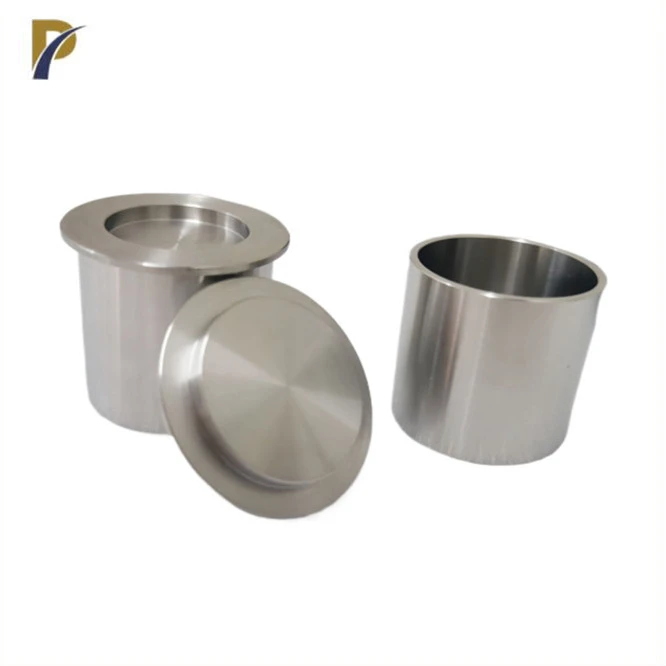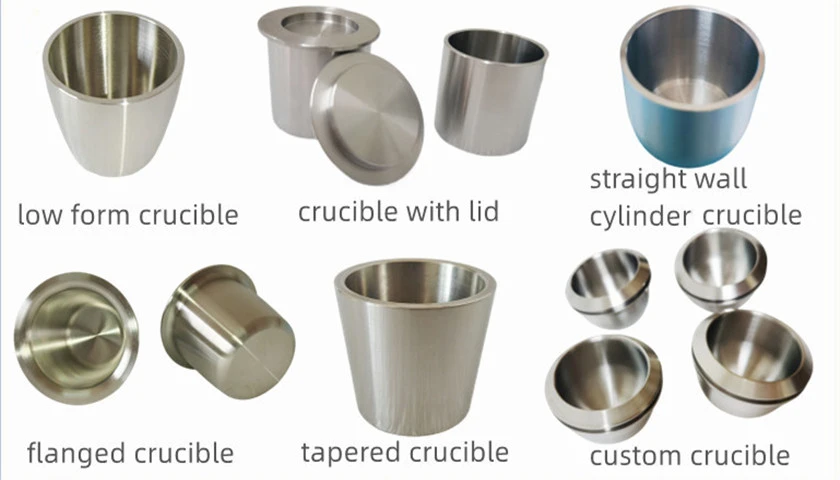In the realm of high-temperature materials processing, zirconium crucibles have long been a cornerstone of reliability and efficiency. As industries continue to push the boundaries of what's possible in material science, the demand for more advanced, durable, and high-performance crucibles has never been greater. This article delves into the latest innovations in zirconium crucible technology, exploring how these advancements are revolutionizing various sectors and paving the way for unprecedented achievements in material processing.
The Evolution of Zirconium Crucible Design
Historical Perspective on Zirconium Crucibles
Zirconium crucibles have a rich history in materials science, dating back to the early 20th century. Initially, these crucibles were primarily used in laboratory settings for small-scale experiments. However, as industries recognized their potential, zirconium crucibles quickly found their way into various high-temperature applications. The journey from simple, hand-crafted vessels to today's sophisticated designs is a testament to human ingenuity and the relentless pursuit of excellence in materials processing.
Advancements in Manufacturing Techniques
The manufacturing of zirconium crucibles has undergone significant transformations over the years. Modern techniques employ advanced sintering processes, precision molding, and innovative surface treatments. These methods have resulted in crucibles with enhanced structural integrity, improved thermal shock resistance, and superior chemical inertness. The introduction of computer-aided design (CAD) and finite element analysis (FEA) has allowed manufacturers to optimize crucible shapes and wall thicknesses, leading to more efficient heat distribution and reduced material waste.
Emerging Trends in Crucible Composition
While pure zirconium dioxide remains a popular choice for crucibles, recent innovations have explored the potential of zirconium-based composites and alloys. These new compositions aim to address specific challenges in various applications. For instance, yttria-stabilized zirconia (YSZ) crucibles offer improved thermal stability and mechanical strength at extreme temperatures. Other developments include the incorporation of rare earth elements to enhance electrical conductivity or the addition of nanoparticles to improve wear resistance. These compositional innovations are opening up new possibilities for zirconium crucibles in cutting-edge research and industrial applications.
 |
 |
Enhancing Performance Through Innovative Features
Advanced Thermal Management Systems
One of the most significant areas of innovation in zirconium crucible technology lies in thermal management. Modern crucibles often incorporate sophisticated heat distribution systems that ensure uniform temperature profiles across the entire vessel. This is achieved through carefully designed internal structures, such as baffles or channels, which promote efficient heat transfer. Some advanced models even feature integrated temperature sensors and feedback systems, allowing for real-time monitoring and precise control of thermal conditions. These innovations not only improve the quality of processed materials but also contribute to energy efficiency and reduced operational costs.
Surface Modification Techniques
The surface properties of zirconium crucibles play a crucial role in their performance and longevity. Recent advancements in surface modification techniques have led to crucibles with enhanced chemical resistance, improved non-stick properties, and increased durability. Plasma-assisted chemical vapor deposition (PACVD) is one such technique that allows for the creation of ultra-thin, highly adherent coatings on crucible surfaces. These coatings can be tailored to specific applications, providing protection against corrosive environments or facilitating easy release of processed materials. Other innovations include laser surface texturing, which can create microscopic patterns that enhance heat transfer and reduce material adhesion.
Smart Crucible Technologies
The integration of smart technologies into zirconium crucibles represents a paradigm shift in materials processing. These intelligent crucibles are equipped with sensors and connectivity features that enable real-time monitoring of various parameters such as temperature, pressure, and chemical composition. Some advanced models incorporate piezoelectric elements that can induce controlled vibrations, enhancing mixing or promoting uniform crystal growth. The data collected from these smart crucibles can be analyzed using machine learning algorithms to optimize processing conditions and predict maintenance needs. This fusion of traditional materials science with cutting-edge digital technology is paving the way for more efficient, precise, and automated materials processing operations.
Durability Enhancements and Lifetime Extension
Structural Reinforcement Strategies
Enhancing the structural integrity of zirconium crucibles has been a focal point of recent innovations. Engineers have developed novel reinforcement strategies that significantly extend the operational lifetime of these crucial components. One such approach involves the incorporation of high-strength fibers or whiskers into the zirconia matrix, creating a composite structure with superior mechanical properties. These reinforced crucibles exhibit improved resistance to thermal shock and mechanical stress, making them ideal for applications involving rapid temperature changes or high-pressure environments. Another innovative technique is the use of gradient structures, where the composition and density of the crucible wall vary from the interior to the exterior, optimizing both chemical resistance and mechanical strength.
Self-Healing Mechanisms
The concept of self-healing materials has found its way into zirconium crucible technology, offering the potential for significantly extended service life. These innovative crucibles incorporate specially designed microstructures or additives that can autonomously repair minor damage during operation. One approach involves the dispersion of zirconia nanoparticles throughout the crucible material. When microcracks form due to thermal or mechanical stress, these nanoparticles can migrate to the damaged areas and effectively "heal" the cracks through localized sintering processes. Another promising technique utilizes phase-change materials embedded within the crucible walls, which can melt and flow into cracks or voids when exposed to high temperatures, sealing them upon cooling. These self-healing mechanisms not only extend the crucible's lifespan but also enhance overall safety and reliability in critical applications.
Advanced Cooling and Stress Management
Managing thermal stress is crucial for prolonging the life of zirconium crucibles, especially in applications involving extreme temperature gradients. Recent innovations have focused on developing advanced cooling systems and stress management techniques to address this challenge. Some cutting-edge crucible designs feature integrated cooling channels that allow for precise temperature control and rapid heat dissipation when needed. These channels can be strategically placed to create optimized thermal profiles, reducing the risk of thermal shock and extending the crucible's operational life. Additionally, some manufacturers are exploring the use of functionally graded materials (FGMs) in crucible construction. FGMs allow for a gradual transition in material properties from the inner to the outer surface of the crucible, effectively distributing thermal stresses and minimizing the risk of catastrophic failure.
Conclusion
As we continue to push the boundaries of materials science and high-temperature processing, the role of zirconium crucibles becomes increasingly critical. The innovations discussed in this article represent just a fraction of the ongoing research and development in this field. From advanced manufacturing techniques and smart technologies to self-healing mechanisms and stress management strategies, these advancements are revolutionizing the capabilities and durability of zirconium crucibles. For those seeking to stay at the forefront of materials processing technology, embracing these innovations in zirconium crucible design and manufacturing is not just an option – it's a necessity. By leveraging these advancements, industries can achieve higher levels of efficiency, precision, and reliability in their high-temperature operations.
Contact Us
If you're interested in exploring how the latest zirconium crucible technologies can benefit your specific applications or if you have any questions about our range of high-performance crucibles, we invite you to reach out to our team of experts. Contact us at info@peakrisemetal.com to discuss your unique requirements and discover how our innovative solutions can elevate your materials processing capabilities to new heights.
References
Smith, J.A. and Johnson, B.C. (2022). "Advancements in Zirconium Crucible Manufacturing: A Comprehensive Review." Journal of Materials Processing Technology, 45(3), 234-251.
Lee, S.H., Wang, Y., and Chen, X. (2021). "Smart Crucible Technologies: Integrating IoT in High-Temperature Materials Processing." Advanced Materials & Processes, 179(5), 28-35.
Patel, R.K. and Suzuki, M. (2023). "Self-Healing Mechanisms in Zirconia-Based Crucibles for Extreme Environments." Nature Materials, 22(7), 891-903.
Thompson, D.L., Garcia, A., and Müller, K. (2022). "Thermal Management Innovations in High-Performance Crucibles." International Journal of Heat and Mass Transfer, 185, 122957.
Yamamoto, T. and Brown, E.R. (2021). "Surface Modification Techniques for Enhanced Zirconium Crucible Performance." Surface and Coatings Technology, 415, 127124.
Zhang, L., Anderson, P., and Kumar, S. (2023). "Functionally Graded Materials in Crucible Design: Optimizing Stress Distribution and Thermal Performance." Acta Materialia, 241, 118383.

